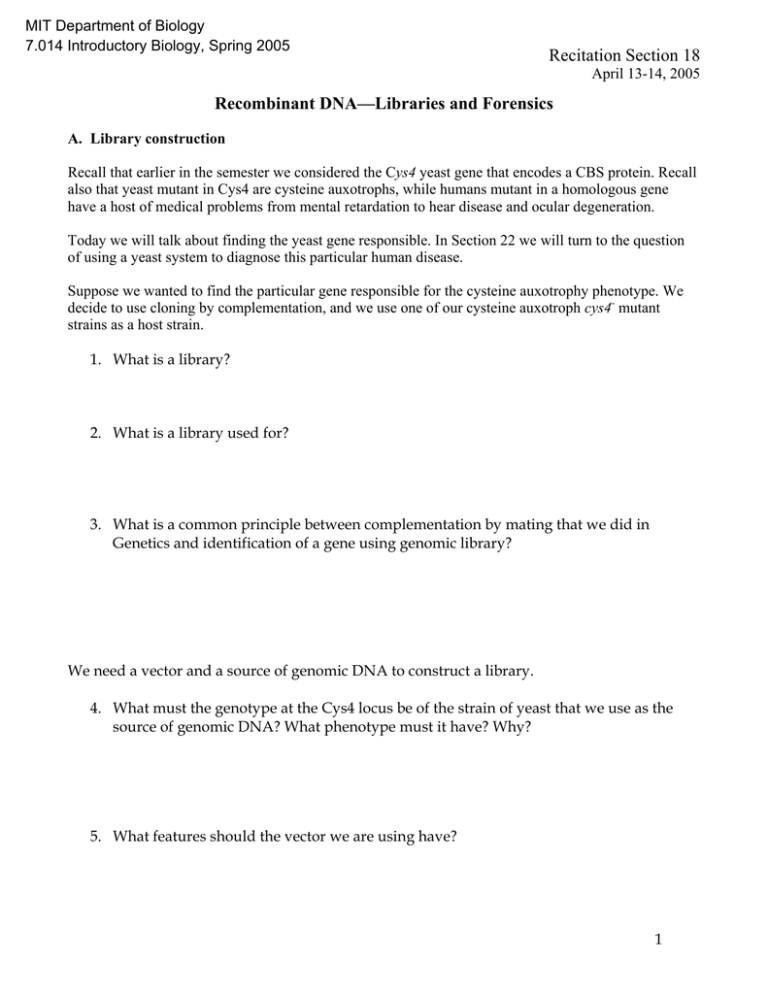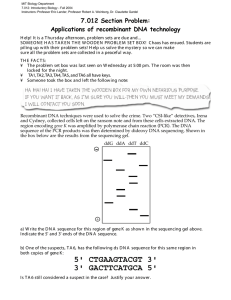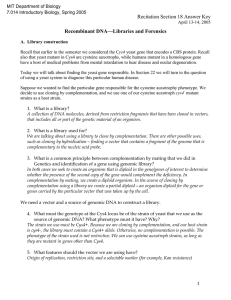Recitation Section 18 Recombinant DNA—Libraries and Forensics
advertisement

MIT Department of Biology 7.014 Introductory Biology, Spring 2005 Recitation Section 18 April 13-14, 2005 Recombinant DNA—Libraries and Forensics A. Library construction Recall that earlier in the semester we considered the Cys4 yeast gene that encodes a CBS protein. Recall also that yeast mutant in Cys4 are cysteine auxotrophs, while humans mutant in a homologous gene have a host of medical problems from mental retardation to hear disease and ocular degeneration. Today we will talk about finding the yeast gene responsible. In Section 22 we will turn to the question of using a yeast system to diagnose this particular human disease. Suppose we wanted to find the particular gene responsible for the cysteine auxotrophy phenotype. We decide to use cloning by complementation, and we use one of our cysteine auxotroph cys4- mutant strains as a host strain. 1. What is a library? 2. What is a library used for? 3. What is a common principle between complementation by mating that we did in Genetics and identification of a gene using genomic library? We need a vector and a source of genomic DNA to construct a library. 4. What must the genotype at the Cys4 locus be of the strain of yeast that we use as the source of genomic DNA? What phenotype must it have? Why? 5. What features should the vector we are using have? 1 6. If we ran a gel of the vector and genomic DNA after the restriction digestion, how many bands would you expect to see in the vector digest lanes? What does your answer depend on? 7. How many cut sites for our restriction enzyme do you expect in the yeast genome? How many bands would that produce? 8. What are the next three steps in library creation? What is the goal of each step? Step Goal 9. If we plated our transformed culture on Complete+Kan media, what would each colony on the plates represent? 10. What media should we plate on to find the cells that took up a vector from the library that contains a wild-type Cys4 gene? B. Application—Solve a mystery BARNEY AND THE BEAVER ARE GONE!! Help us solve the mystery so Professor Walker can continue to bring his trusted visual aids to 7.014. FACTS: • Barney and the beaver were seen by all in lecture on Wednesday, February 2. • The last time Barney and the beaver were seen was at a staff meeting in Professor Walker's office immediately after that lecture. • Melissa, Luke, Cindy, Eric, Julia, and Professor Walker were all present at the meeting. • One of these staff members (not Professor Walker) took the props. 2 The techniques of dideoxy DNA sequencing and the polymerase chain reaction (PCR) were used to solve the crime. Cells left on the ransom note were isolated and the region containing gene K amplified by PCR. The DNA sequence of the PCR products was then determined. Shown in the box below are the results from a sequencing gel of a region of gene K. - ddG ddA ddT ddC + 1. Write the DNA sequence for this region of gene K as shown in the sequencing gel above. Indicate the 5' and 3' ends of the DNA sequence. 2. One of the suspects, Cindy, has the following ds DNA sequence for this same region in both copies of gene K: 5' CTGAAGTACGT 3' 3' GACTTCATGCA 5' Is Cindy still considered a suspect in the case? Justify your answer. Analysis of a second site, the gene L locus (represented by the shaded box below), is useful for forensics. The only difference between the two alleles at this locus is that the l allele lacks an internal EcoRI restriction site present in the L allele. EcoRI L allele: l allele: PCR analysis of cells taken from the note indicated that it was handled only by a Ll individual. Based on this, the gene L locus of the suspects was amplified by PCR, the PCR products were digested with EcoRI, and the resulting fragments were separated by agarose gel electrophoresis as shown below: 3 Luke M a r is s a Julia Ad a m Eric Fa ng Cindy A lex JeMelissa s s ica – Larg er fr a g m e n t s Sm a l l e r fr a g m e n t s + ge n o ty p e : 3. In the spaces provided above, indicate the genotypes at the gene L locus for these suspects. 4. Based on the PCR analysis of the gene L locus, which individual(s) can be excluded as suspects in the crime? Justify your answer. At chromosomal position Z, it is common to find one or more copies of a 100 bp insert. Fortunately, most of the suspects have a different number of inserts at this position. We even tested Professor Walker to be sure: Eric has no inserts. Luke has one insert. Melissa has two inserts. Cindy has two inserts. Julia has three inserts. Professor Walker has four inserts. A partial DNA sequence of position Z is given below. The length of position Z without an insert is 2000 bp. 5'-GTGCA.... ....CGACG-3' 100 bp insert 3'-CACGT.... ....GCTGC-5' n [ ] 5. To determine who took Barney and the beaver, design a PCR-based strategy to analyze position Z, including the sequences and orientation (5' and 3' ends) of two 5-base primers necessary to PCR amplify this region. 4 Sample from the ransom note Molecular marker 6. The following pattern was seen on the gel used to seperate the PCR products from the above experiment. 1 2 3 4 5 6 2500 2400 2300 2200 2100 2000 i) Which lane corresponds to which individual? ii) Who committed this heinous crime? 5








